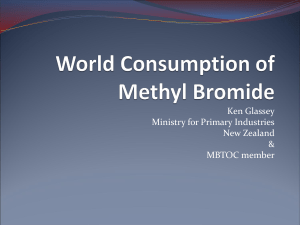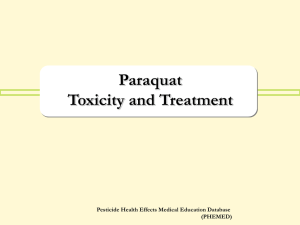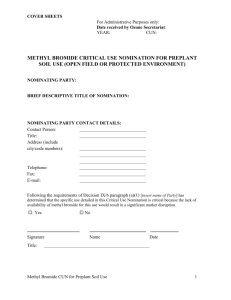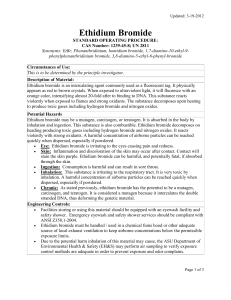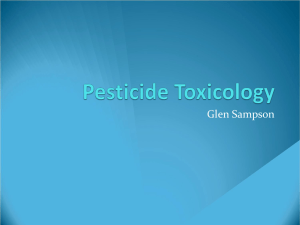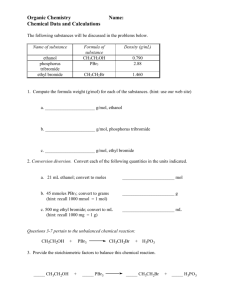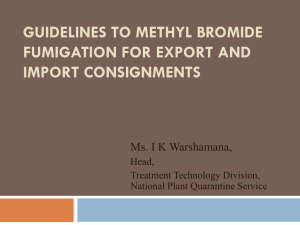Pesticide Illness Part 3 - Association of Occupational and
advertisement
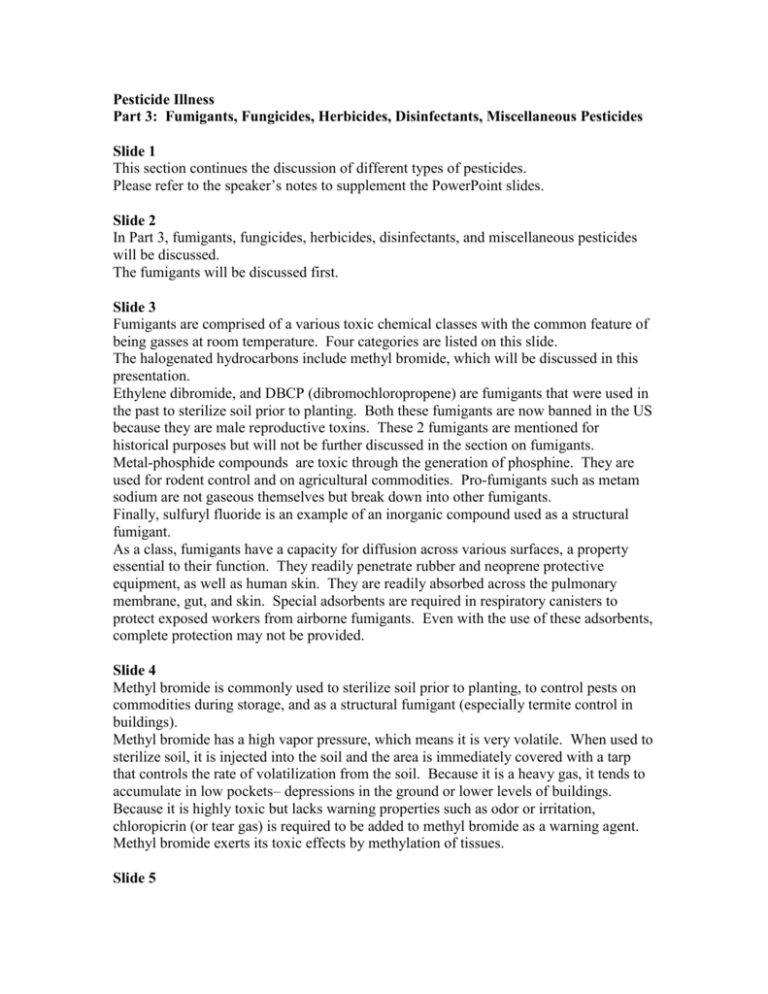
Pesticide Illness Part 3: Fumigants, Fungicides, Herbicides, Disinfectants, Miscellaneous Pesticides Slide 1 This section continues the discussion of different types of pesticides. Please refer to the speaker’s notes to supplement the PowerPoint slides. Slide 2 In Part 3, fumigants, fungicides, herbicides, disinfectants, and miscellaneous pesticides will be discussed. The fumigants will be discussed first. Slide 3 Fumigants are comprised of a various toxic chemical classes with the common feature of being gasses at room temperature. Four categories are listed on this slide. The halogenated hydrocarbons include methyl bromide, which will be discussed in this presentation. Ethylene dibromide, and DBCP (dibromochloropropene) are fumigants that were used in the past to sterilize soil prior to planting. Both these fumigants are now banned in the US because they are male reproductive toxins. These 2 fumigants are mentioned for historical purposes but will not be further discussed in the section on fumigants. Metal-phosphide compounds are toxic through the generation of phosphine. They are used for rodent control and on agricultural commodities. Pro-fumigants such as metam sodium are not gaseous themselves but break down into other fumigants. Finally, sulfuryl fluoride is an example of an inorganic compound used as a structural fumigant. As a class, fumigants have a capacity for diffusion across various surfaces, a property essential to their function. They readily penetrate rubber and neoprene protective equipment, as well as human skin. They are readily absorbed across the pulmonary membrane, gut, and skin. Special adsorbents are required in respiratory canisters to protect exposed workers from airborne fumigants. Even with the use of these adsorbents, complete protection may not be provided. Slide 4 Methyl bromide is commonly used to sterilize soil prior to planting, to control pests on commodities during storage, and as a structural fumigant (especially termite control in buildings). Methyl bromide has a high vapor pressure, which means it is very volatile. When used to sterilize soil, it is injected into the soil and the area is immediately covered with a tarp that controls the rate of volatilization from the soil. Because it is a heavy gas, it tends to accumulate in low pockets– depressions in the ground or lower levels of buildings. Because it is highly toxic but lacks warning properties such as odor or irritation, chloropicrin (or tear gas) is required to be added to methyl bromide as a warning agent. Methyl bromide exerts its toxic effects by methylation of tissues. Slide 5 Methyl bromide is a vesicant and causes severe skin blistering on direct contact or exposure to very high air levels. The photo on the right shows a case of blistering dermatitis of the foot associated with application of methyl bromide. Most fumigant dermatitis cases involve the feet, as shown in the photo on the top right. The photo on the bottom right shows blistering dermatitis in the axillary area of fumigations workers who wore respiratory protection but no dermal protection inside a fumigated structure Methyl bromide may cause delayed effects on the lower respiratory tract. Inhalation exposure may result in pulmonary edema, with delayed onset 4-12 hours after exposure. For suspected inhalation exposure to methyl bromide, patients should be hospitalized overnight for observation. Because of its poor water solubility, methyl bromide does not cause upper airway irritation. However, upper airway irritant effects may result from exposure to chloropicrin. Symptoms and signs of central nervous system depression due to methyl bromide range from headache, dizziness, nausea, and vomiting, to tremors, weakness, diminished reflexes, and seizures. CNS depression is the most common cause of death following acute methyl bromide exposure. References: Fuortes LJ. A case of fatal methyl bromide poisoning. Vet Hum Toxicol 1992; 34:2. Goldman L, et al. Acute symptoms in persons residing near a field treated with the soil fumigants methyl bromide and chloropicrin. West J Med 1987; 147:95-98. Hustinx WNM, et al. Systemic effects of inhalational methyl bromide poisoning. Brit J Indust Med. 1993; 50:155-159. Slide 6 The differential diagnosis of methyl bromide toxicity may include other causes of CNS depression, such as solvents and drug overdose, stroke, or infectious agents. Noncardiogenic causes of pulmonary edema, such as hepatic or renal disease or acute, severe asthma, may need to be considered if the exposure history of the patient is unknown. Slide 7 Management of methyl bromide poisoning is primarily supportive. Blood bromide levels may be obtained to confirm suspected exposure to methyl bromide. Bromide levels are indicators of exposure, not disease severity. Based on published case reports, levels may be roughly correlated with categories of clinical outcomes. 3-6 ppm: Exposure may have occurred at this lower limit, but no symptoms are expected >15 ppm: Symptoms of acute poisoning may be observed above this level >50 ppm: Severe symptoms or death may be observed above this level. 50ppm is the lowest serum bromide level associated with death. In some European countries, bromide levels may be used for biologic monitoring of manufacturing workers. Note that bromide levels may be reported in a variety of units, as indicated in the table at the right. The detection of serum bromide does not itself indicate that exposure has occurred to methyl bromide. Some foods, especially seafood, and certain medications contain inorganic bromide and consumption may result in asymptomatic elevation of bromide levels. Bromide levels gradually return to normal, the duration determined by the peak level and acuity of exposure. As with most other pesticides, treatment is supportive and based on clinical suspicion, not laboratory results. For example, breathing support should be provided in instances of respiratory failure; anticonvulsants are indicated for seizures. References: Hoizey G et al. An unusual case of methyl bromide poisoning. J Toxicol Clin Toxicol. 2002;40(6):817-21. Muller M et al. Photometric determination of human serum bromide levels--a convenient biomonitoring parameter for methyl bromide exposure. Toxicol Lett. 1999 Jun 30; 107:155-9. Pond S. Paraquat and diquat. In Goldfrank’s Toxicologic Emergencies, Goldfrank LR, et al. (eds). 1990. East Norwalk, CT: Appleton & Lange. 4th edition. Slide 8 There are few well-controlled studies of the effects of chronic, low-level methyl bromide toxicity. However, case reports have documented cognitive dysfunction, behavioral changes, and progressive ascending sensory polyneuropathy. Methyl bromide is a methylating agent, a weak mutagen, and possible animal carcinogen. It is teratogenic in animal studies. Induction of DNA damage has not been documented among methyl bromide applicators. Reference: Pletsa V et al. Monitoring for DNA damage of humans occupationally exposed to methyl bromide. Anticancer Res. 2002 Mar-Apr; 22:997-1000. Slide 9 Serum bromide levels may not be useful in the evaluation of chronic exposure, as they correlate poorly with toxic effects in these cases. The serum half-life is 11-15 days, so bromide may be detected 1-2 weeks after exposure has ceased. In cases of chronic exposure, levels of 50-100 ppm may be observed without signs or symptoms of toxicity. Recently, special testing has shown that protein adducts formed after exposure to methyl bromide may be a better measure of significant exposure. Adducts have been used to confirm acute methyl bromide toxicity 10 weeks after an exposure. Their use in assessment of chronic exposure has not been tested. The photo at right shows a residence next to a tarped field where methyl bromide was applied. Reference: Buchwald AL. Late confirmation of acute methyl bromide poisoning using Smethylcysteine adduct testing. Vet Hum Toxicol. 2001 Aug; 43:208-11. Slide 10 A woman lived in a spare room adjacent to a guest house treated for termites because of a pending sale. She was in her room the evening the adjacent structure was fumigated. The next day, she was in the house intermittently, but retired early in the evening because of flu-like symptoms. Slide 11 The guest house had been fumigated with methyl bromide. The pesticide applicator, homeowner, and resident of the guest house were unaware of an uncovered electrical conduit passing between the two buildings. Slide 12 The homeowner brought a prospective client to the guest house the following evening and found her tenant convulsing on the floor. The tenant’s initial serum bromide level was 270 ppm The tenant never recovered consciousness and died 19 days later from refractory seizures, intermittent fever, and multi-organ failure. Reference: Michalodimitrakis MN et al. Death following intentional methyl bromide poisoning: toxicological data and literature review. Vet Hum Toxicol. 1997 Feb; 39:30-4. Slide 13 Because methyl bromide depletes the protective layer of ozone, a gradual phase-out of production has been scheduled, with complete cessation of production to be completed by 2005. At this time, it does not seem that the reduction will truly cease, since there will be exemptions for certain uses. These include “critical agricultural uses” (agricultural uses for which no feasible alternative is available), pre-shipment and quarantine uses, and “emergency uses”. Furthermore, although there are a few alternatives to certain uses of methyl bromide, users of the pesticide feel that an ideal substitute has yet to be developed. Some proposed alternatives to methyl bromide include sulfuryl fluoride and metam sodium. While methyl bromide may be used for both agricultural and structural applications, sulfuryl fluoride is used only for structural applications and metam sodium for agricultural ones. Slide 14 Sulfuryl fluoride is the principal alternative to methyl bromide for structural fumigation. It is not an option for pre-plant fumigation. In part because it has not been used extensively until recently, human toxicity information on sulfuryl fluoride is inadequate. Like methyl bromide, sulfuryl fluoride lacks warning properties and exerts pulmonary and CNS toxicity. Chloropicrin is added as a warning agent to sulfuryl fluoride applications. Signs of exposure may include dyspnea and cough. Delayed pulmonary edema may occur and exposure may warrant hospitalization for monitoring. Fatal hypoxia has been reported following early re-entry into treated structures. Renal injury with proteinuria and azotemia has been reported. Signs and symptoms of CNS toxicity include weakness, nausea, vomiting, restlessness, muscle twitching, and seizures. Although it is not known to cause ozone depletion and the available literature suggests that it is not as toxic as methyl bromide, it is not an ideal substitute because of its toxic properties. Slide 15 Metam sodium is used as a pre-plant soil fumigant and is an alternative to methyl bromide. As use of methyl bromide in agricultural applications has been decreasing, metam sodium use has risen. Metam sodium is not an ideal substitute for methyl bromide because it is not useful for structural fumigations and is not non-toxic. Metam sodium is a pro-fumigant. That is, it is not itself a gas at room temperature, but hydrolyzes to form a mixture of irritant gasses: Hydrogen sulfide, carbon disulfide, methylamine, methyl isothiocyanate (MITC) and methyl isocyanate (MIC). MITC is the primary irritant gas formed by hydrolysis of metam sodium. Although the most irritating of the gasses formed is MIC, the gas released in the 1984 accident in Bhopal, India, it is formed in small quantities and is unlikely to be the major irritant released by metam sodium hydrolysis. Health effects due to MITC and the other irritant gasses consist of irritant dermatitis and reactive airways dysfunction syndrome or exacerbation of pre-existing asthma. Slide 16 The following case illustrates health effects caused by an accidental spill of metam sodium. A 40 year-old male transportation worker was evaluated by his primary care physician for acute onset of metallic taste, detecting an unusual odor, burning eyes, chest and nose, nausea, and dizziness. He was off work for the next 5 days due to recurrent cough with wheezing and phlegm. After returning to work, he noted cough on exposure to diesel exhaust (to which he was exposed in his line of work), chest tightness and dyspnea on exertion. He smoked 1.5 packs per day for 7 years. Prior to this episode, he was in good health, without a history of bronchitis or asthma. Reference: Cone J, et al. Persistent respiratory health effects after a metam sodium pesticide spill. Chest. 1994; 106:500-508. Slide 17 The worker relayed the following occupational exposure history: Prior to developing symptoms, he was called to aide in the response to a train derailment. Several tank cars had fallen into the river in a rural area, releasing more than 19,000 gallons of the pesticide metam sodium. The worker began work alongside the derailment. His symptoms began 20 minutes after beginning work. He worked for 6.5 hours alongside the river. He denied direct contact with the spilled pesticide or the river water. Slide 18 The spilled metam sodium traveled down the river over several hours, resulting in the off-gassing of irritant compounds along the entire river. The transportation worker was one of many workers responding to the spill and residents along the river with persistent respiratory effects. The photo to the right shows the effects of the spilled metam sodium on the aquatic life all along the river. The metam spill killed fish along the 40 mile length of the river over 3 days. Because of continuing symptoms, the worker was referred for evaluation at a university occupational medicine clinic. Exam 6 months following the spill showed mild nasal inflammation; his lungs were clear and the chest X-ray was normal. Spirometry results were consistent with mild airways obstruction: FEV1:87% predicted, FVC:101% predicted; ratio of FEV1 to FVC: 69% FEF25-75: 26% predicted. Methacholine challenge test performed 9 months after the spill showed airway irritability (airway responsiveness increased by 100% at a lower dose of methacholine than in normal individuals). The medical and exposure history suggest that his symptoms were consistent with nonspecific airway hyperresponsiveness caused by inhalation exposure to the irritant gases produced by hydrolysis of metam sodium. Slide 19 Long-term low-level exposure to both methyl bromide and sulfuryl fluoride has been reported to cause chronic neurologic deficits. The literature includes both case reports and studies evaluating neuropsychological tests among chronically exposed workers. Methyl bromide is a well-known animal reproductive toxin. As illustrated by the case of the transportation worker, airway irritability may persist for months after even brief exposure to metam sodium, resulting in reactive airways dysfunction syndrome (RADS) or asthma. Metam sodium has been shown to be a reproductive toxin in animal feeding studies Methyl isothiocyanate (MITC) studies show have shown no chronic effects, but several studies allege chronic health effects of caused by one of the byproducts of metam sodium, methyl isocyanate (MIC), following the 1984 release of MIC in Bhopal, India. Health effects commonly found in these studies include chronic inflammatory ocular conditions, adverse reproductive outcomes (spontaneous abortions), and chronic pulmonary conditions, primarily fibrosing bronchiolitis obliterans. Slide 20 In this next case, metam sodium exposure resulted from drift following an agricultural application. As shown in the photo to the right, metam sodium was applied by sprinkler to carrot fields. Illnesses were reported among children at a neighboring school, resulting in school evacuation. Illnesses were also reported among several groups of workers: employees at the school that was evacuated and other non-agricultural workers up to 1 mile from the pesticide application site. The most common symptoms reported among workers were teary and irritated eyes, headache, nausea, cough, and upper respiratory pain and irritation. Slide 21 There were two important findings from the investigation of this incident: 1. MITC was detected at the school, beyond the 500 ft. “buffer zone”. A buffer zone is the area between the edge of the application site “sensitive receptors” or areas where individuals at risk for pesticide illness may be located. Sensitive receptors may be schools, hospitals, etc. 2. The applicators were required to monitor the field for MITC odor. If odor was detected, the workers were to apply additional water by sprinkler to slow rate of volatilization. This practice was specified on the pesticide label and was intended to minimize MITC exposure to the community. Based on these findings, recommendations were made to: Increase the buffer zone to 1 mile for 72 hours for sprinkler applications of MITC to minimize exposure (This type of change in regulation may occur at the county level.). Cease the practice of using odor as a field monitoring practice. Because the label specifies that workers must conduct odor monitoring, this type of recommendation is a lengthy process that involves working with US EPA as well as state agencies. Slide 22 The next category of fumigants we will discuss are the phosphide compounds. Metal phosphides such as aluminum, zinc, magnesium phosphides hydrolyze to produce the toxic gas phosphine. Phosphine is colorless, and has a characteristic odor described as fishy or garlicky. It is highly explosive and corrosive. Sweat, oil from skin can initiate breakdown of phosphine tablets, shown in the photo. Phosphine readily oxidizes in the body, ultimately to phosphoric acid. No diagnostic tests are available for phosphine exposure due to its rapid oxidization. Slide 23 Illness due to low level exposure to phosphine may resemble common viral illnesses, with symptoms of dizziness, headache, cough, and airway irritation. More severe exposures may result in dyspnea, delayed pulmonary edema, and CNS toxicity, which may manifest as staggering gait, tremor, diplopia, and hallucinations. Ingestion results in multi-system failure with cardiac toxicity (arrhythmias, S-T segment changes, heart block, pericarditis), renal failure, adrenal injury, and liver necrosis . Slide 24 An unemployed male stowed away in a railcar traveling between Texas and California. The railcar was fumigated with aluminum phosphide in transit. His badly decomposed body was found on arrival in California. Death was most likely due to pulmonary and CNS toxicity. Phosphine is highly corrosive and hastens tissue decomposition. Reference: Mehler L, et al. Deaths associated with exposure to fumigants in railroad cars--United States. MMWR. 1994; 43:489-91. Slide 25 The next category that will be presented are the fungicides, an important and widely used group of pesticides. There are several different types of fungicides. The thiocarbamate group includes zineb, maneb, ziram, and thiram. The pthalimide derivative captan will be discussed. Chlorothalonil, and hexachlorobenzene are substituted aromatic compounds. Sulfur is a commonly used inorganic fungicide, and is allowed in organic as well as conventional agriculture. Slide 26 Fungicides are well-known to cause both acute and chronic dermatologic effects. Chronic exposure may be carcinogenic. Slide 27 The thiocarbamate fungicides chemically resemble the rubber accelerator thiuram, a common sensitizer in standard skin patch test series. Sensitization has been reported in workers exposed to thiocarbamates through treated seeds, application on golf courses, and handling ornamental flowers with residues. Important members of this group shown on the right include manganese and zinc bisdithiocarbamates (zineb and maneb). Slide 28 In addition to skin irritation, antabuse-like reactions may be observed with the thiocarbamate thiram and the rubber accelerator thiuram. Workers may experience severe flushing reactions with headache, nausea and vomiting if alcohol is ingested shortly after exposure. This reaction resembles “degreaser’s flush” associated with tetrachlorethylene. Slide 29 In a crew of 30 people picking Bosc pears, 26 complained of skin rashes on their arms, hands, faces and abdomens. Physical exams were consistent with contact dermatitis Five days before picking, the following were applied aerially: -NAA 800, a growth regulator used to prevent premature fruit drop -Ziram Granuflo, a fungicide Slide 30 As specified by label requirements, the workers did not reenter the field until the pesticide had dried (specific number of days or hours were not specified). Ziram applications had been made to D'Anjou pears and Golden Delicious apples as well as to Bosc pears. However, only workers picking Bosc pears had symptoms. The mechanism of dermatitis was postulated : -Sharp latent buds form on Bosc pears. -Skin abrasions during picking may have formed as a result of these buds and increased the workers’ susceptibility to dermal irritation. Slide 31 Data received from the manufacturer of ziram indicated that the half-life of this fungicide on pears is 9 days. Although geographic and weather conditions affect the half-life of pesticides, no information was available on the variability of ziram’s half-life. The re-entry interval (REI) is the time between pesticide application and the time when workers are allowed to enter the treated field. The REI was increased to 14 days in the state where this incident occurred, based on the half-life of ziram in the field on the reported human exposure incident described in this case. Slide 32 Like the thiocarbamates, the pthalimide derivative, captan causes skin irritation. Dermatitis associated with spraying captan on apples is a relatively frequently reported problem in some states. Human Draize (irritation) tests on human volunteers show that 5% of those tested are sensitized to captan. Slide 33 A worker in a redwood nursery complained of itching and hives at work. Patch testing with chlorothalonil (used in the nursery) provoked local Type I allergic reaction (immediate hypersensitivity with dermal erythema, inflammation). Open test with 1% chlorothalonil provoked a systemic Type I reaction (wheezing). Reference: Dannaker CJ, et al. Contact urticaria and anaphylaxis to the fungicide chlorothalonil. Cutis. 1993; 52:312-315. Slide 34 This photo shows a banana plantation worker with blue-gray pigmentation in the antecubital area. Patch testing with chlorothalonil resulted in a positive skin reaction. The diagnosis is ashy dermatitis, an unusual pigmentary reaction to chlorothalonil. Reference: Penagos H, et al. Chlorothalonil, a possible cause of erythema dyschromicum perstans (ashy dermatitis). Contact Dermatitis. 1996; 35:214-218. Slide 35 Chlorothalonil disrupts the basal membrane of the epidermis. Histological examination reveals melanin deposits in dermis. Clinically, this manifests as ashy dermatitis. Slide 36 Sulfur is a widely used fungicide, especially on grapes (both table and wine grapes). It is one of the few pesticides used in organic farming. Large number of cases suggest that elemental sulfur is a potent skin irritant. However, animal experiments on sulfur-induced skin irritation are equivocal. Conflicting results may be due to differing product compositions and experimental conditions. There are sporadic reports of upper airway irritation or exacerbation of pre-existing asthma following exposure to elemental sulfur used as a pesticide. However, the literature fails to support sulfur as an airway irritant. Some of the variability in sulfur-induced skin and airway irritation may be explained by environmental oxidation/reduction of sulfur. Oxidation products of sulfur such as sulfites, sulfuric acid, and hydrogen sulfide are well-documented airway irritants. Slide 37 A pesticide applicator developed a rash on his arms while dusting roses with sulfur. The applicator complained of burning. The pattern of lesions corresponded to places where dust settled on sweaty skin, and was consistent with contact dermatitis due to sulfur. Reference: O’Malley M. Skin reactions to pesticides. State of the Art Reviews in Occupational Medicine 1997; 12:327-345 Slide 38 Workers with a history of sulfur application in nurseries show positive patch test reactions to sulfur. This is the most frequent single allergic reaction to pesticides. There are only occasional literature reports describing allergic reactions to sulfur. However sulfur-induced allergy is supported by reported cases of contact allergy and IgE sensitivity to sulfites. Slide 39 Oxidation or reduction products of sulfur, such as sulfites or sulfuric acid, hydrogen sulfide may be the cause of allergic reactions. The exact mix of products is determined by pH, temperature, and ionic strength of the product. Contact dermatitis caused by sulfur is consistent with a Type IV delayed hypersensitivity reaction. Slide 40 Herbicides are commonly used around the world. Important herbicides include the dipyridyls: paraquat and diquat, glyphosate, and the phenoxy compounds 2,4,5-T and 2,4D. Slide 41 Both paraquat and diquat are nonselective contact herbicides that can exert similar significant systemic toxicity. Although it is a restricted pesticide in the US and banned in several Western European countries, paraquat is widely used, primarily in developing countries, primarily because it is labor-saving, cheap, and readily available. Because of their similar toxicities, only paraquat will be discussed. The photo at right shows a banana plantation worker in South America. Sweat and oil from the skin can initiate breakdown of phosphine tablets. Paraquat is commonly used in banana agriculture. Reference: Ruha AM, Set al. Dilute diquat death. Am J Emerg Med. 2001; 19:527. Wesseling C, et al. Paraquat in developing countries. Int J Occup Environ Health. 2001; 7:275-286. Slide 42 Paraquat is extremely toxic via ingestion, with effects on multiple organs. The LD50, or 50% lethal dose, is 3-5 mg/kg or 10-15 ml of a 20% solution. Because of its toxicity, green coloring is added as warning property to paraquat solutions. Toxicity is primarily directed at the skin and lungs. It has also been alleged that there is a risk for Parkinson’s disease following exposure, although the evidence is equivocal. Slide 43 Dermal contact with paraquat may result in blisters, ulcers, and fissured skin. The photo on the left shows bullous contact lesions in an exposed patient. Based on undetectable blood levels of paraquat at the time photographs were taken, systemic absorption did not occur. Nail damage and loss is a significant feature of paraquat dermal toxicity, as seen in the photo at right. Ocular exposure may result in corneal opacification Inhalation exposure may cause nose and throat irritation, including nosebleeds. Reference: Botella R, et al. Contact dermatitis to paraquat. Contact Dermatitis. 1985; 13:123-4. Hoffer E and Taitelman U. Exposure to paraquat through skin absorption: clinical and laboratory observations of accidental splashing on healthy skin of agricultural workers. Hum Toxicol. 1989 Nov;8(6):483-5 Slide 44 Paraquat is most toxic following ingestion. GI irritation with edema and ulcers begin 1-4 days following ingestion. This is followed by hepatic and renal injury. Pulmonary fibrosis manifests last, 72-96 hours after ingestion, but is usually the cause of death. (In slide show mode, press space bar) The diagram at right shows the mechanism of paraquat-induced pulmonary fibrosis. Paraquat, or PQ on the diagram, is actively taken up by pulmonary alveolar eptithelial cells, where enzymatic reduction and reaction with oxygen yields the di-cation PQ2+ and a highly reactive superoxide radical (O2-). Superoxide and its detoxification products damage the lipid membranes of cellular components and the cell dies. Contributing to cell death are the cell’s attempts to detoxify paraquat, which depletes NADPH, and results in disruption of important biochemical processes. Slide 45 As with other pesticides, the clinician should look for clues in the history that suggest that paraquat exposure has occurred. Exposure to a green liquid is one such clue. If exposure is suspected, paraquat levels of the pesticide in body fluids should be obtained to confirm exposure. Blood or urine paraquat levels most likely underestimate the dose absorbed following ingestion exposure, but they may predict survival. Gastric contents may also be assayed for paraquat, but there is no clinical correlation. Based on human case series, blood and urine levels may be roughly correlated with outcome: Survival is likely if urine levels within the first 24 hours are less than 1 mg/mL and plasma levels are < 20 mg/kg. Gastrointestinal effects are likely even at these levels. At higher levels, both urine and plasma concentrations can be used to predict either pulmonary fibrosis with delayed death or death within 24 hours due to multi-organ failure. However, urine levels associated with these outcomes vary widely. Nomograms are often used to predict the prognosis in cases of ingestion exposure. References: Hart TB et al. A new statistical approach to the prognostic significance of plasma paraquat concentrations. Lancet. 1984; 2:1222-1223 Scherman JM et al. Prognostic value of plasma and urine paraquat concentration. Human Toxicol. 1987; 6:91-93 Vale JA, et al. Paraquat poisoning: clinical features and immediate general management. Hum Toxicol. 1987; 6:41-47. Slide 46 Decontamination of dermal and eye exposures by removal of clothing and thorough lavage with soap and water or eye irritation is essential to minimize direct toxicity and absorption. Treatment for paraquat poisoning will be most effective if administered within 2 hours of ingestion. Beyond this time, plasma concentrations may increase rapidly by several orders of magnitude. If ingestion is suspected, further absorption should be prevented by immediately decontaminating the GI tract with Fuller’s Earth and Bentonite, which bind paraquat well. If they are not available, activated charcoal may be administered. Gastric lavage is contraindicated if more than 1 hour has elapsed since ingestion, because of the risk of exacerbating mucosal damage. Gastric contents (and contaminated clothing) may be assayed for paraquat. Because oxygen increases the availability of superoxide radicals, oxygen administration is contraindicated except to relieve air hunger in severe hypoxemia. Although fluid administration, hemodialysis, and hemoperfusion have been recommended to eliminate paraquat, they have not been shown to improve survival. They may, however, be used to treat resulting renal insufficiency. High dose steroids and cyclophosphamide may improve the survival of severe cases. Antioxidants have been proposed as therapy; captopril has been successfully used in animals to prevent pulmonary fibrosis. References: Camdan R and Alagozlu H. Captopril inhibits the pulmonary toxicity of paraquat in rats. Human Exp Toxicol. 2001; 20:637-641. Pond S. Paraquat and diquat. In: Goldfrank LR et al., (eds.). Goldfrank’s Toxicologic Emergencies. 1990; 4th ed. East Norwalk, CT: Appleton & Lange. Suntres A. Role of antioxidants in paraquat toxicity. Toxicology. 2002; 180:65-77. Slide 47 In a suicide attempt, a 46 year old male farmer intentionally ingested a greenish liquid stored on his farm an hour before seeking medical attention. He had not eaten since the evening before. In the emergency room, he complained of dysphagia and sore throat. Past medical history was significant for a depression and a previous suicide attempt. Paraquat ingestion was suspected, based on the color of the liquid. In the hospital, profuse, prolonged vomiting was observed. He was initially treated with oral Fuller’s Earth and mannitol, and IV hydration. The plasma paraquat level 4 hours after ingestion was 3 mg/mL. 24 hours after ingestion, the serum creatinine was twice normal. Slide 48 On day 2, the farmer complained of severe dysphagia; his abdomen was distended and decreased bowel sounds were present. On day 3, he complained of shortness of breath; crackles were audible at the left base and air entry was decreased at the right base. The chest X-ray showed right basilar atelectasis. Over the next 5 days, renal and pulmonary function continued to deteriorate. The chest X-ray, shown on the slide, revealed diffuse alveolar infiltrates, most marked in the perihilar regions. The pO2 on room air was 33 mm Hg. Although his renal function improved, the farmer died on day 12 due to extensive proliferative pulmonary fibrosis. Factors that contributed to fatal outcome in this patient include: Ingesting paraquat on an empty stomach, which most likely contributed to a rapid rise in plasma levels. Relatively high plasma level of paraquat at 24 hours (based on a commonly used nomogram, a plasma level of 3 mg/mL 4 hours after ingestion is associated with a 75% chance of dying) Slide 49 The next herbicide we will discuss is glyphosate. While it is not as systemically toxic as paraquat, it is widely used as an herbicide by both professional applicators and homeusers, resulting in large numbers of potentially exposed persons. There are case reports of eye and skin irritation following exposure to glyphosate. The skin effects are often described as an erythematous, pruritic rash. However, experimental studies fail to show skin irritation. Animal studies show respiratory tract irritation following intra-tracheal instillation. Ingestion of large amounts of glyphosate has been used successfully to commit suicide. Health effects observed include mucosal and gastrointestinal irritation, metabolic acidosis, hypotension, respiratory failure, and renal insufficiency. The mechanism of human toxicity is unknown. The surfactant, an isothiazoline preservative, may contribute to the irritant effects. Slide 50 Chlorophenoxy herbicides are sometimes mixed into fertilizers for control of broadleaf weeds. Several hundred products contain chlorophenoxy herbicides in various forms and concentrations. 2,4,5-T and 2,4-D are two herbicides that belong to this class. 2,4,5-trichlorophenoxyacetic acid (2,4,5-T) is manufactured by hydroxylation of tetrachlorobenzene. 2,4,5-T was used as Agent Orange during the Vietnam War. It is best known for its dioxin contaminants, the byproducts of an exothermic manufacturing process. This herbicide is no longer produced in the US. 2,4-dichlorophenoxyacetic acid (2,4-D) is manufactured by the chlorination of phenol, and does not contain dioxin contaminants. Slide 51 Chlorophenoxy herbicides are moderately irritating to skin and mucous membranes. Inhalation may result in cough and burning sensations in the nasopharynx and chest. Information on systemic toxicity derives from cases of deliberate suicidal ingestion, mostly involving 2,4-D. At high doses, CNS findings predominate, with symptoms including stiffness of arms and legs, incoordination, lethargy, anorexia, stupor, and coma. Patients present with vomiting, diarrhea, headache, confusion, and bizarre behavior that may be rapidly followed by progression to coma. Renal failure with metabolic acidosis and multi-organ failure may follow. Muscle weakness may persist for months after acute poisoning. Muscle weakness and peripheral neuropathy have also been observed following occupational exposure. Chronic oral exposure to 2,4-D results in anemia, decreased liver enzyme activity, and increased kidney weight have been observed in animals. Several human studies have suggested an association between exposure to 2,4-D (and other herbicides) and an increased incidence of tumor formation. However, it is not clear whether this represents a true association, and, if so, whether it is specifically related to 2,4-D. Some studies have reported increased incidences of tumors in orally exposed animals. EPA has not classified 2,4-D as to its human carcinogenicity. Dioxin contaminants produced during the production of 2,4,5-T have been associated with chloracne. However, the pesticide itself is not associated with this condition. Reference: US EPA. 2,4-D (2,4-Dichlorophenoxyacetic Acid). Air Toxics Website 2003. http://www.epa.gov/ttn/atw/hlthef/di-oxyac.html Slide 52 As mentioned in the first part of this curriculum, US EPA considers antimicrobials and disinfectants pesticides as they are used to kill pests. These compounds are used in a wide variety of workplaces as well as homes. Commonly used disinfectants are sodium hypochlorite, or bleach, isopropyl alcohol, gluteraldehyde, and formaldehyde. (Formaldehyde is a gas at room temperature and is considered a fumigant.) The aldehydes are primarily respiratory irritants and sensitizers. Hypochlorite by itself is a skin irritant and causes burns of the GI mucosa if ingested. (In slide show mode, press space bar or next slide) However, inappropriate mixtures of hypochlorite with acids or ammonia produce chlorine gas and chloramines and are responsible for large numbers of illnesses in a variety of occupational settings as well as homes. Slide 53 Chlorine-containing antimicrobials are often mixed with acids or ammonia in an attempt to improve cleansing ability. The resulting products, chlorine gas and chloramines, are acute respiratory irritants that may result in acute bronchitis and exacerbation of existing asthma. Persistent effects of acute exposure include chronic bronchitis and reactive airways dysfunction syndrome (RADS). Treatment is supportive: oxygen and bronchodilators. Prophylactic antibiotics and systemic steroids have not been shown to improve the prognosis. Slide 54 A 29 year-old custodian is seen in the emergency room with a cough, sore throat and extreme shortness of breath. At work, he mixed ammonia and bleach to clean a particularly stubborn stain in a bathroom. He smokes 1 pack of cigarettes a day. On exam, he is coughing, dyspneic, and tachypneic, with respiratory rate of 36; Lungs reveal scattered rales and wheezes; oxygen saturation is 94% on room air, 96% on 5L O2 The peak expiratory flow rate is 80%, lower than expected for a young, healthy worker. The custodian’s diagnosis is acute bronchitis with bronchospasm. He should be treated with supplemental oxygen, Atrovent and Albuterol. He will need follow up to monitor for RADS and bronchitis. Incidentally, this worker was driven to the ER by a coworker who brought the empty but open bottles containing the bleach and ammonia with him in the car. He complained of a sore throat. Exam revealed mild pharyngeal erythema. Upper airway irritation resulted from exposure to hypochlorite fumes. He was treated with throat lozenges. Slide 55 Dermatologic effects predominate the health effects of pesticides. Two miscellaneous pesticides with skin effects are briefly presented, propargite, an acaricide, and DEET, an insect repellant. Slide 56 Although there are no reports of systemic toxicity, propargite causes severe skin irritation. The photo at right shows scarring as a result of severe dermatitis in citrus harvesters despite use of long sleeves. These workers were exposed to high levels (0.89-5.49 µg/cm2) of a prolonged release formulation of propargite that persisted beyond the restricted entry interval. Reference: Saunders DL, et al. Outbreak of Omite CR-induced dermatitis among orange pickers in Tulare county, California. J Occup Med. 1987; 29:409-413. Slide 57 DEET is a widely used insect repellant that is sometimes applied directly to the skin. It is severely irritating in high concentrations (>30%). The photo at right shows blistering (an irritant reaction) due to the concentrated DEET used by the military (US, Israeli). Consumer use formulations, typically in concentrations under 30% DEET, may result in contact urticaria. Central nervous system effects, such as seizures and encephalopathy are rare. They are more likely in children under the age of 5, and when high doses or concentrated formulations are used. For this reason, if DEET must be used, it is advisable to apply DEET to clothing instead of directly to the skin, particularly in children and when open sores or other dermatologic conditions are present. References: Maibach HI and Johnson HL. Contact urticaria syndrome. Contact urticaria to diethyltoluamide (immediate-type hypersensitivity). Arch Dermatol. 1975 Jun;111(6):726-30. Wantke F, et al. Patch test reactions in children, adults and the elderly. A comparative study in patients with suspected allergic contact dermatitis. Contact Dermatitis. 1996; 34:316-319. Slide 58 Because the acute toxicity of a wide variety of pesticides were described in this curriculum, only the general principles will be summarized here. While pesticides can affect any organ system, the most commonly affected are the skin, lungs, and central nervous system. The severity and target organ of pesticide-related health effects varies by type of pesticide, dose, and route of exposure. Geographically, the most severe health effects occur in developing nations because of the cheap and ready availability of extremely toxic pesticides and the lax enforcement of any laws that may exist. Pesticide-related health effects occur as a result of use at the workplace or at home, but may also be due to drift or other secondary exposure. Prevention of pesticide related illness is multifactorial, and includes surveillance and investigation of illness, enforcement of existing laws, strengthening of ineffective laws, and substituting toxic pesticides with less toxic substances.
